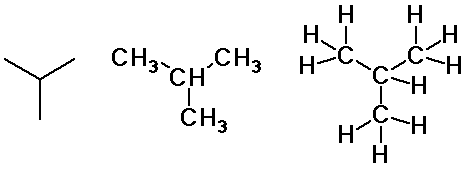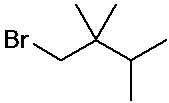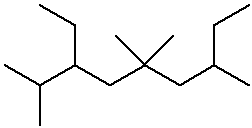
Chapter 2 Notes: Alkanes and Cycloalkanes

Hydrocarbons
- contain only C and H
- form basic carbon skeleton
- functional groups:
only C-H and C-C single bonds (alkanes)
C=C double bond (alkenes)
C=C triple bonds (alkynes)
rings (cycloalkanes, bicycloalkanes, polycycloalkanes)
aromatic rings (arenes)
Alkane Family
- methane CH4
- ethane CH3CH3
- propane CH3CH2CH3
- butane CH3CH2CH2CH3
- alkane CH3(CH2)nCH3
- CnH2n+2 (homologous series)
Higher Alkanes
- pentane C5H12
- hexane C6H14
- heptane C7H16
- octane C8H18
- nonane C9H20
- decane C10H22
- note the Greek prefixes
Alkane Isomers
straight-chain
branched-chain
cyclic chain
atoms connected in a different order
butane and isobutane
3 pentane isomers
Butane isomers
n-butane 
isobutane 
Pentane Isomers
- n-pentane
- isopentane
- neopentane
Alkyl Groups
n-propyl alcohol 
isopropyl alcohol 
(constitutional isomers)
Butyl Groups
- n-butyl
- sec-butyl
- isobutyl
- tert-butyl
Classification of C Atoms
- 1° - primary - bonded to one other C
- 2° - secondary - bonded to 2 other C's
- 3° - tertiary - bonded to 3 other C's
- 4° - quaternary - bonded to 4 other C's
- class also applies to H atoms or functional groups attached
to that C
Identifying Carbon Classes
- identify the classes of each C, H and functional group
in the molecule below

IUPAC Nomenclature
(substituents)-(parent alkane)-(family)
Cl-CH2CH2-OH
2-chloro ethan ol
IUPAC Rules
- parent = longest continuous carbon chain
- number chain from end closest to a substituent (1st difference)
- assign numbers to each substituent
- in naming, arrange substituents alphabetically
- for multiple substituents, use prefixes di-, tri-, tetra-,
etc.
but they don't count when alphabetizing
- separate names from numbers with hyphens, numbers from
numbers with commas
- otherwise all written as one word
IUPAC Examples
- name the three isomers of pentane
- name the four isomers of C4H9Br
IUPAC Examples


Cycloalkane nomenclature
Writing Skeletal Structures
- omit C-H bonds
- assume C makes 4 bonds
- omit C atoms
- assume C at end of every bond
- especially useful for cyclic structures
- be able to put back all the details
Practice with Line Structures
 methylcyclohexane
methylcyclohexane
Alkanes - physical properties and sources
Reactions of alkanes
- combustion
- halogenation (later)
Heats of combustion
- comparison of relative stabilities of isomers
Oxidation-reduction reactions
- alkanes > alkenes > alkynes
- oxygen functional groups: alcohols > carbonyl (aldehyde/ketone)
> carboxylic acid > CO2
- other reactions




![]()
![]()
![]() methylcyclohexane
methylcyclohexane